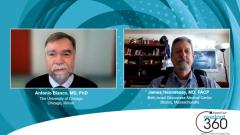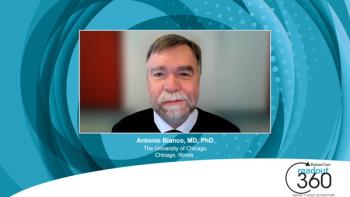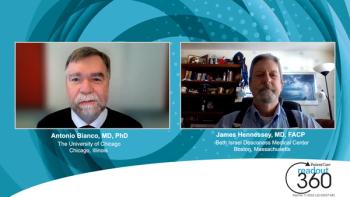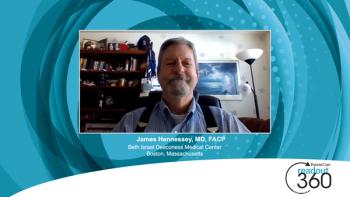
Impact of Age and Concomitant Drug Interactions on TSH Levels in Hypothyroidism
James Hennessey, MD, FACP, and Antonio Bianco, MD, PhD, discuss the role of age and concomitant drug interactions in maintaining optimal TSH levels for hypothyroidism management.
Episodes in this series

Antonio Bianco, MD, PhD: The other factor is, many of our patients are older individuals, and they’re taking different medications for different chronic conditions. That is the other complicating factor I see. We always tell them, just take the levothyroxine by itself, and then you must wait until you take the next pill. That’s a complicating factor.
James Hennessey, MD, FACP: It is.
Antonio Bianco, MD, PhD: What are the most frequent comedications that you see these patients taking that could affect the effectiveness of the levothyroxine treatment?
James Hennessey, MD, FACP: That’s a very practical and important question. I would point out that our listeners might want to look at Salman Razvi’s [MD] review of things that change the TSH [thyrotropin] while you have patients on thyroxin that you should take into consideration. Among the things that increase the TSH, which would be diminishing its effectiveness, would be calcium and iron or iodide supplements, as well as soy and other forms of dietary intake. At the same time, drug interactions are numerous. There are many drugs, including aluminum hydroxide, and things like calcium carbonate and binding resins, etc.
Antonio Bianco, MD, PhD: And colestyramine.
James Hennessey, MD, FACP: Exactly. That will bind with thyroxin and make it essentially nonabsorbable. As simple a thing as proton pump inhibitors [PPIs], because proton pump inhibitors increase the gastric pH, the pill that the patient swallows might not dissolve in that environment as well as it would if it was gastric acid. This is different depending upon the different kinds of thyroxin formulations that are out there. What I mean by that is a lactose-based tablet might have different dissolution characteristics than something with methylcellulose, and both have different dissolution characteristics versus liquid thyroxin….
Antonio Bianco, MD, PhD: Also, the effect of the proton pump inhibitor lasts for the whole day.
James Hennessey, MD, FACP: Yes, it does.
Antonio Bianco, MD, PhD: It’s not a local effect trapping the levothyroxine, it’s a prolonged effect. I was always telling my patients, as long as you wait 4 hours to take that, it should be fine. Well, for most of the drugs you mentioned, 4 hours should be fine, but not for proton pump inhibitors because they’re supposed to act 24 hours per day.
James Hennessey, MD, FACP: Exactly. I agree with you that for things like iron and calcium, aluminum hydroxide, bile acid sequestrants, and raloxifene, the recommendation in…review was take your thyroxin at least 4 hours before doing this. With all those medications, it’s quite possible you could take them at noon, or at supper in the evening, and avoid this whole thing. When it comes to things like soy, milk, or breakfast, all of those should be done optimally an hour after ingesting the medication.
Antonio Bianco, MD, PhD: There are some medications that will affect the kinetics of the hormones. For example, oral contraceptives or even testosterone gels will affect the amount of binding proteins and clearance of thyroid hormone from the circulation. For patients who are on levothyroxine, and after they are placed on oral contraceptives, we should expect a bump up in the dose of levothyroxine because the TSH will fluctuate a little. Usually, what do you think, it’s like 3 months until a new steady state is reached?
James Hennessey, MD, FACP: I think that’s correct. It all depends on how long the TBG [thyroxine-binding globulin] levels continue to rise and expand the binding. I agree with you, after a while a new equilibrium is reached so that we would be back at steady state. That reinforces the statement you said before about, let’s be consistent.
There was an interesting study that was published in 2015 from Savannah Irving, and they looked at about 11,000 patients on thyroxin and measured TSH periodically. They were identifying those where the TSH values were off and looking at whether new medications were added here, does that explain this? This is not a universal study looking for every single interaction that might be possible, but they were able to note that iron, calcium, PPIs, and estradiol all resulted in elevated TSH levels. A portion of this was when statins were introduced, that was associated with a slight decline in TSH levels for some reason. They were unable to identify any changes in TSH with H2 blockers or glucocorticoids in general practice. This is real-world addition of medications.
When I’m thinking about these concepts, there is an esoteric portion of this that comes into the sway, and that is summarized in the Razvi study where they talk about causes of aberrant TSH results. If you’ve got somebody on thyroxin and you’re following their TSH to titrate their dosage, these are things that should be kept in mind. The ones we’ve already mentioned interfere with absorption of thyroxin, but some of them interfere with the actual laboratory testing itself, like the presence of heterophilic antibody, macro TSH, and crazy things like that.
Antonio Bianco, MD, PhD: Absolutely. That’s more common than you would expect.
James Hennessey, MD, FACP: Exactly. With some things you can’t predict what’s going to happen, like lithium, or looking at the diurnal variation of measuring TSH first thing in the morning versus at the end of clinic at 6 o’clock at night.
Antonio Bianco, MD, PhD: Do you think that makes a big difference, for example, because sometimes you’re seeing a patient in the afternoon, and you say, well, let’s check your TSH right now.
James Hennessey, MD, FACP: I asked one of the fellows yesterday, “Are you interested in diagnosing subclinical hypothyroidism, or would you like to downplay that?” And he said, “I don’t understand what you mean.” I said, “If you wait until 5:30 this afternoon and measure the TSH, you’ll probably see the nadir versus having them come in in the morning first thing, where you’re probably going to see higher levels.”
Antonio Bianco, MD, PhD: I see.
James Hennessey, MD, FACP: When the patient’s TSH is hovering around the upper end of the normal range, that can sometimes result in an elevated level, or at least catching the asterisks with a red number.
Antonio Bianco, MD, PhD: So, you think it’s important?
James Hennessey, MD, FACP: I think it can make a difference.
Antonio Bianco, MD, PhD: I see.
James Hennessey, MD, FACP: It’s something to keep in mind as a finer point, I suppose.
Transcript edited for clarity
Newsletter
Enhance your clinical practice with the Patient Care newsletter, offering the latest evidence-based guidelines, diagnostic insights, and treatment strategies for primary care physicians.





























































































































































































































































































































